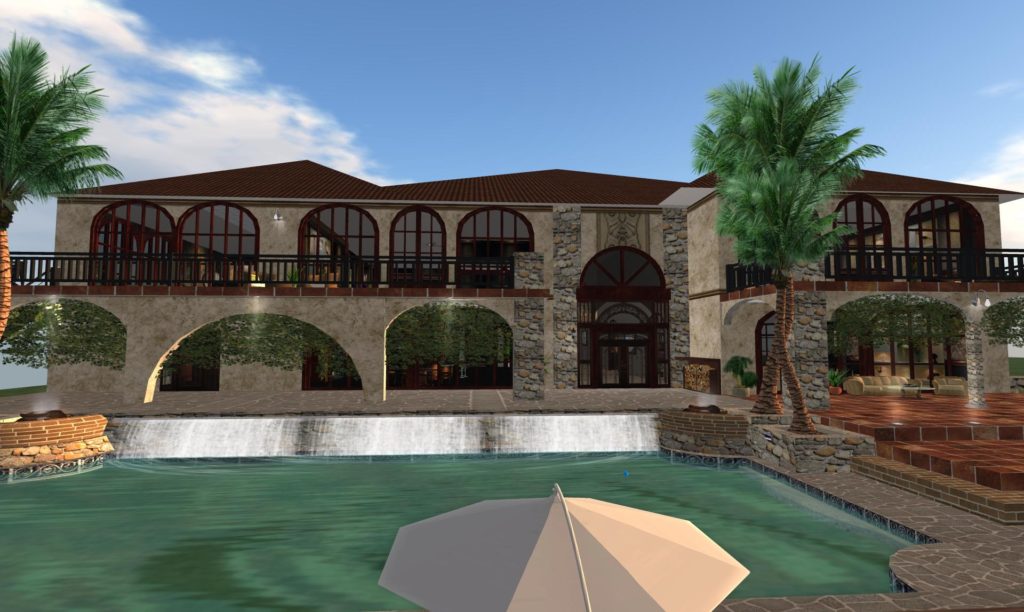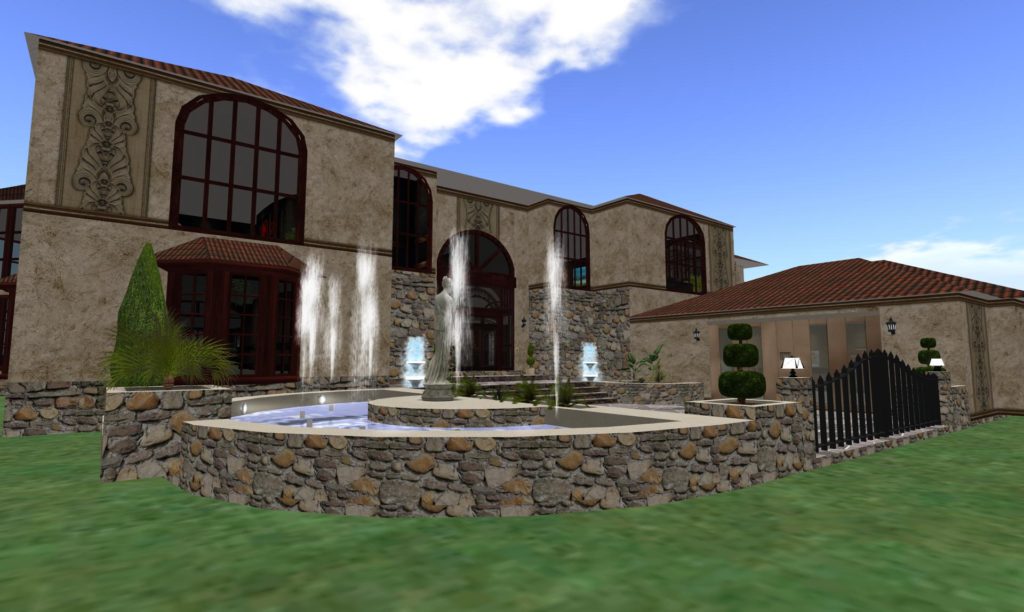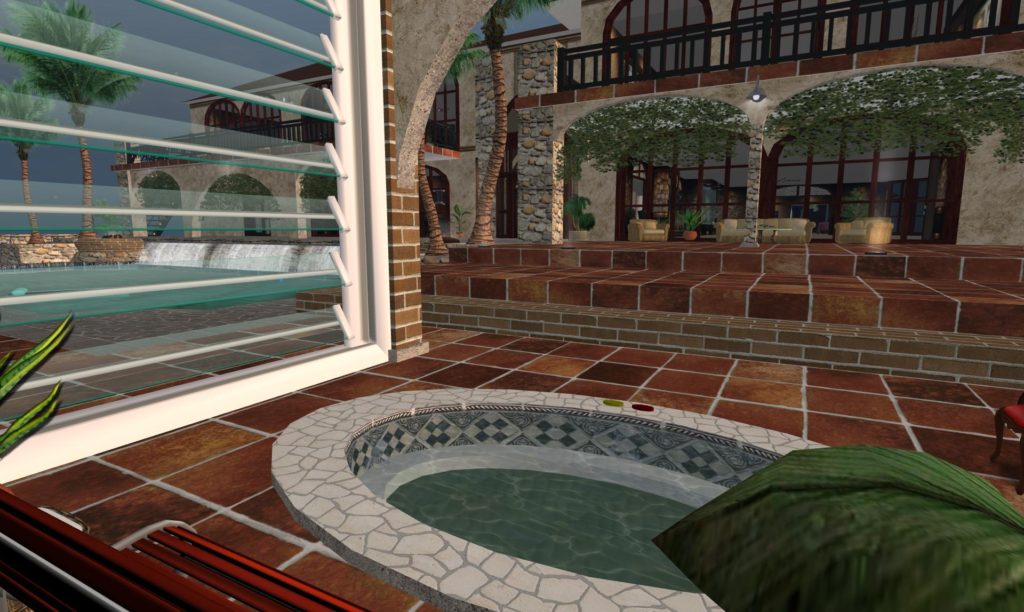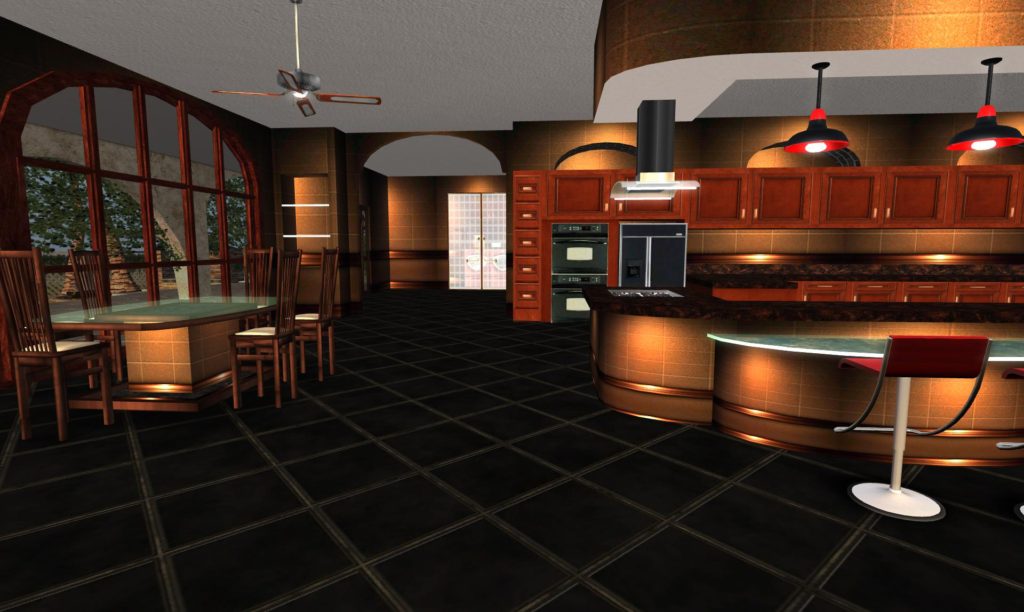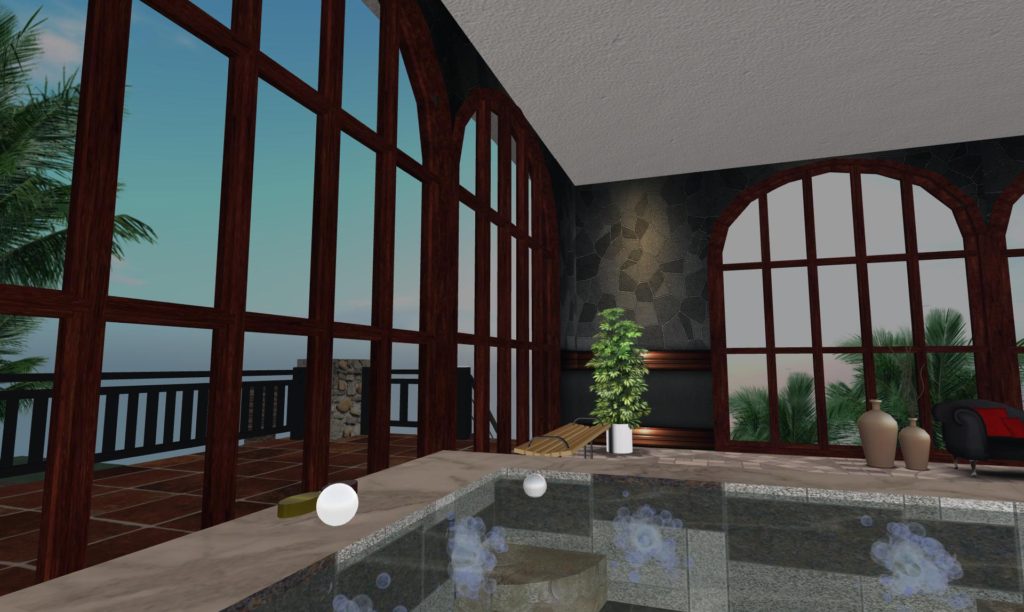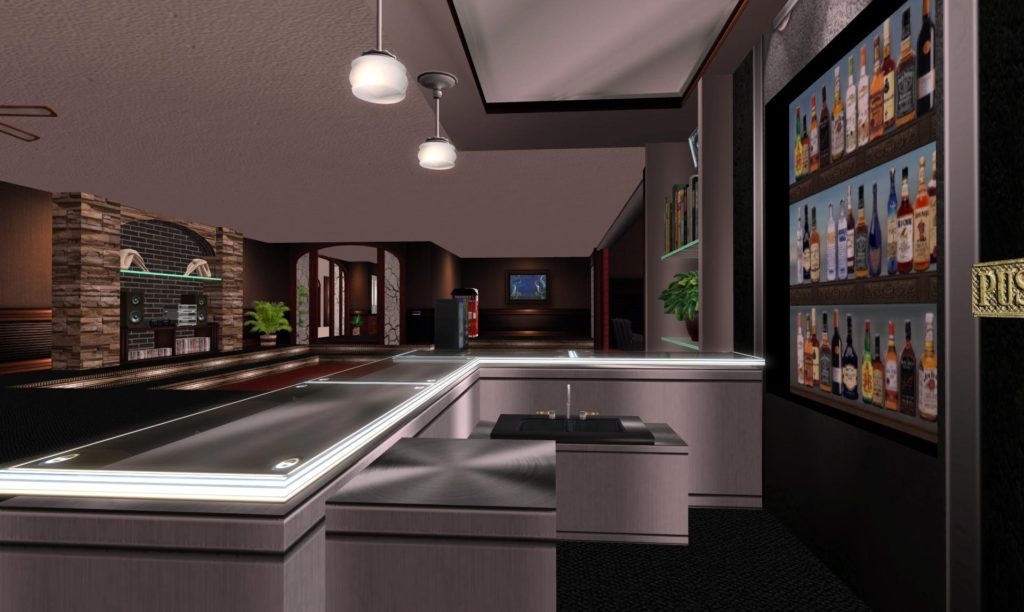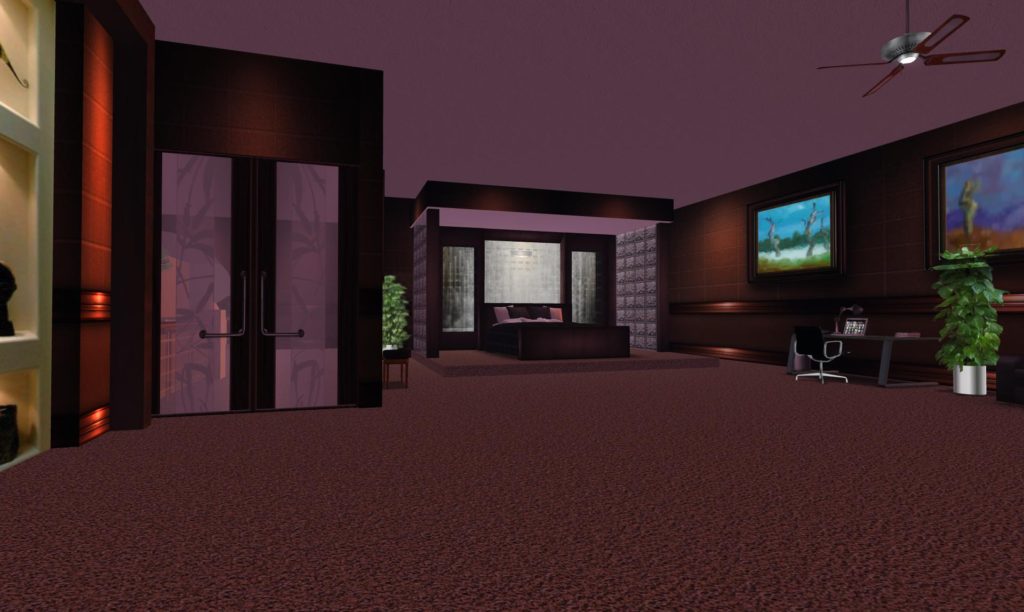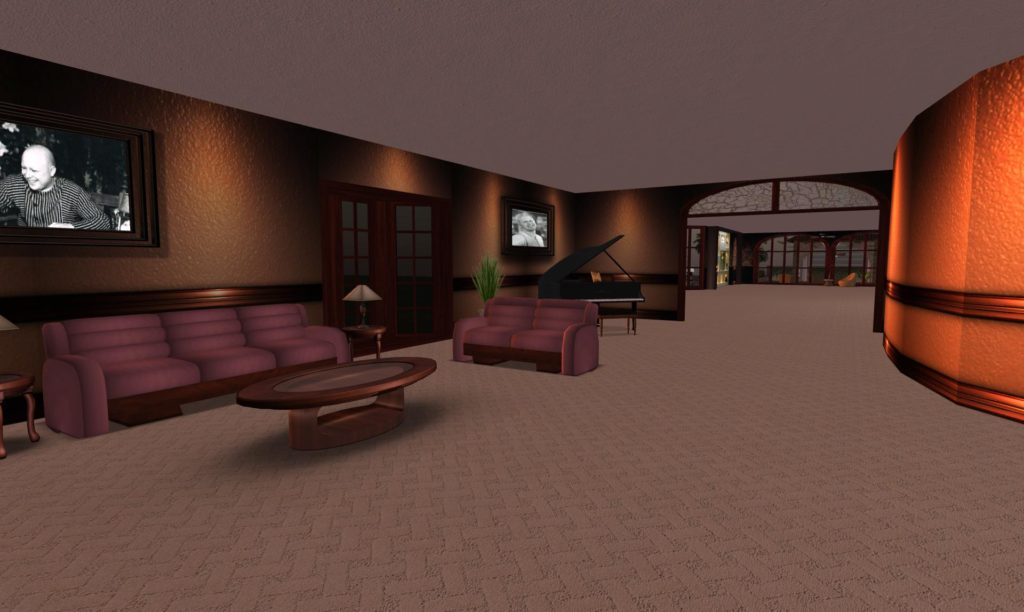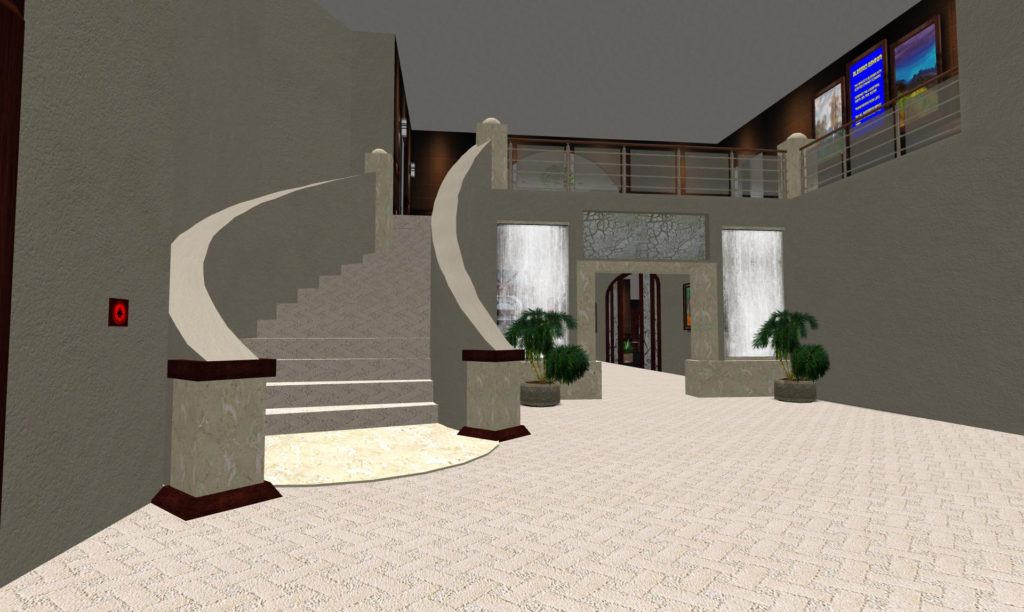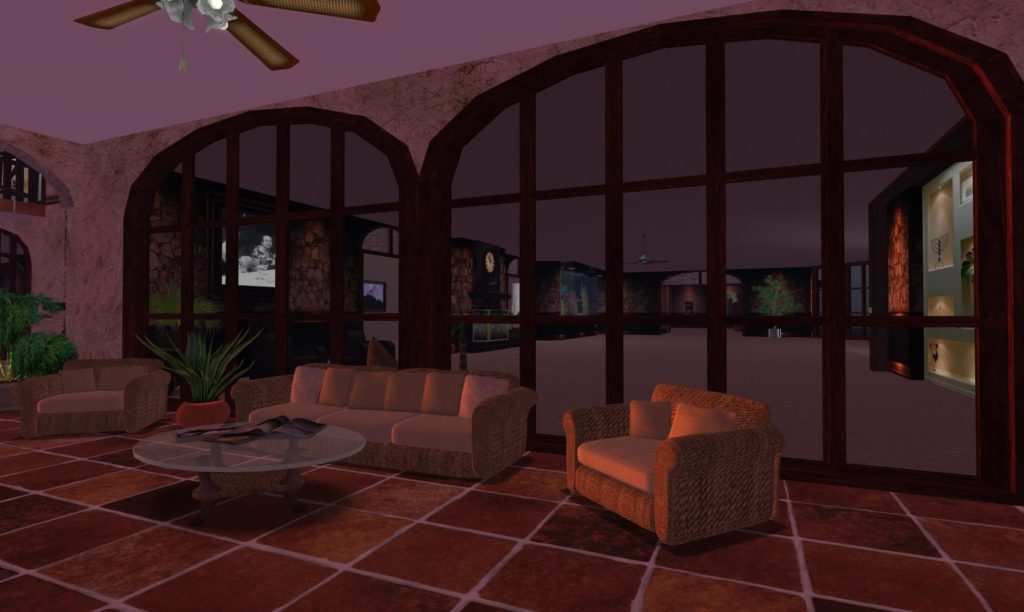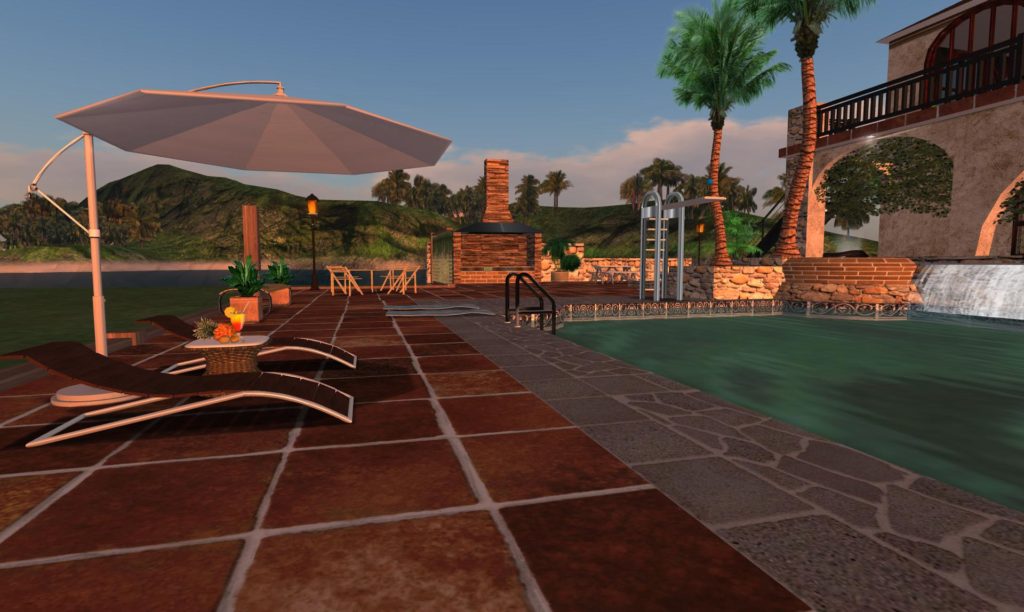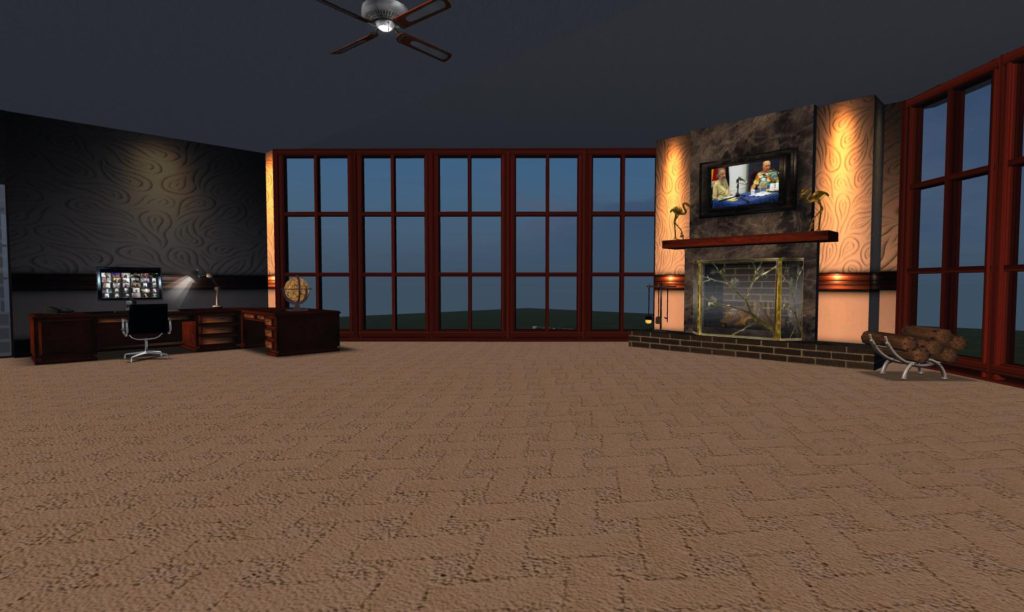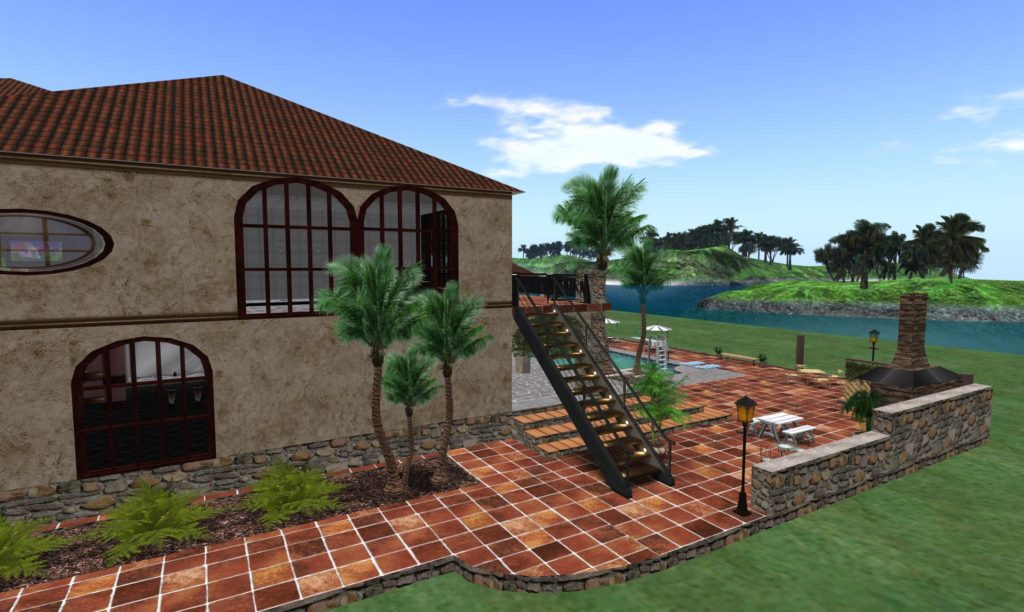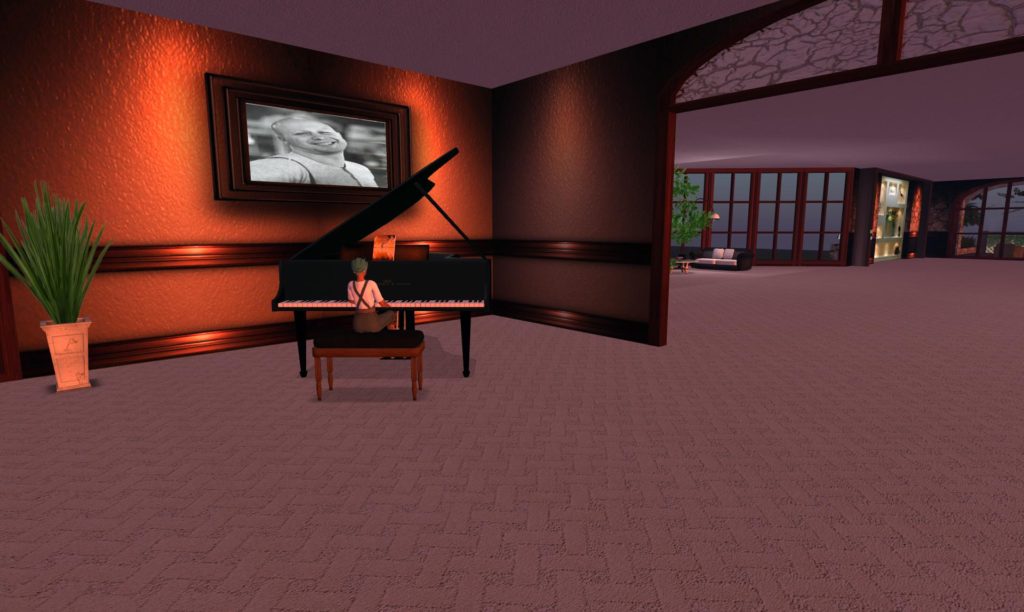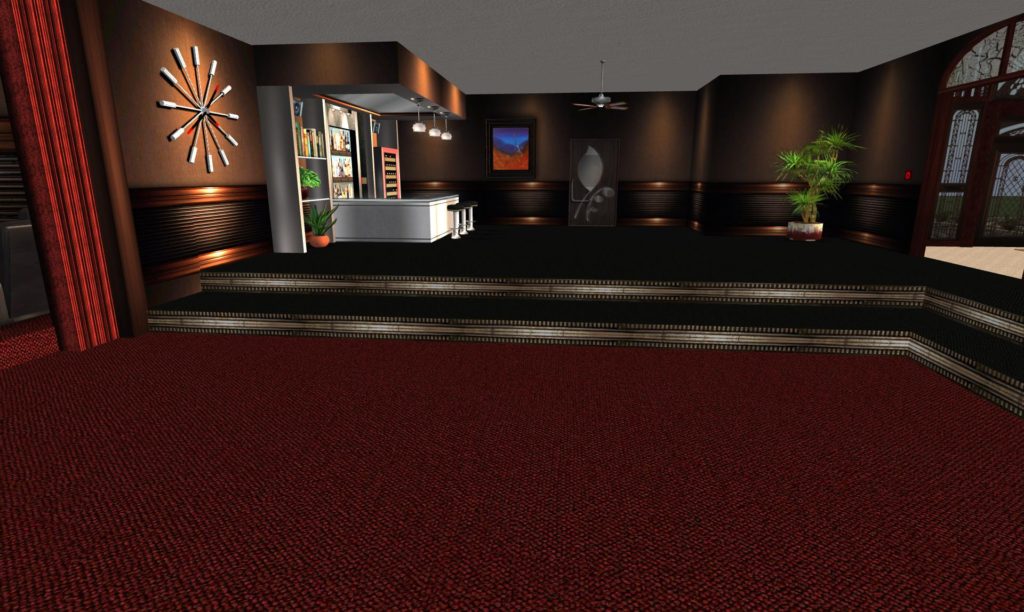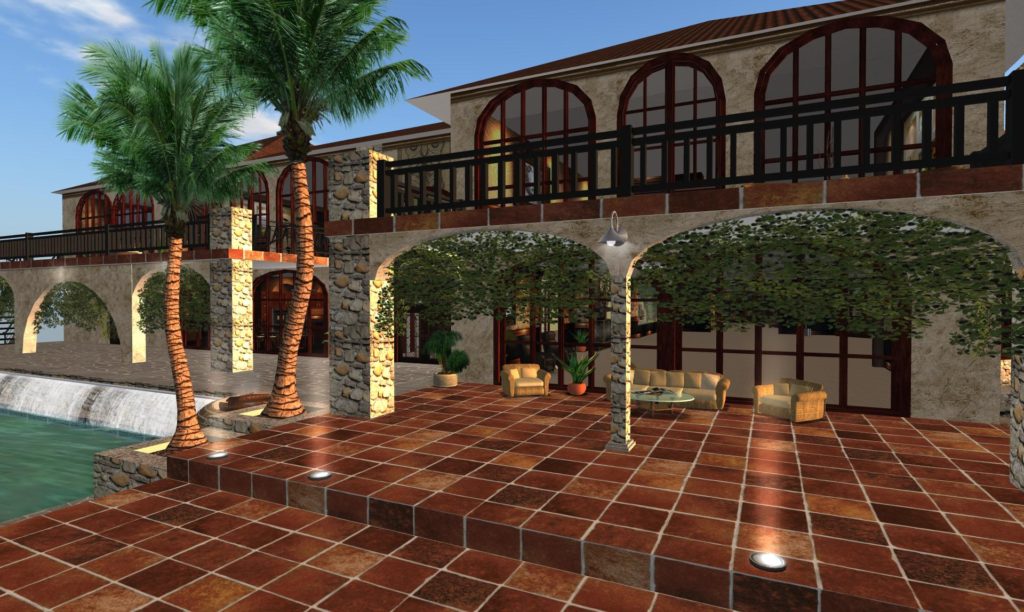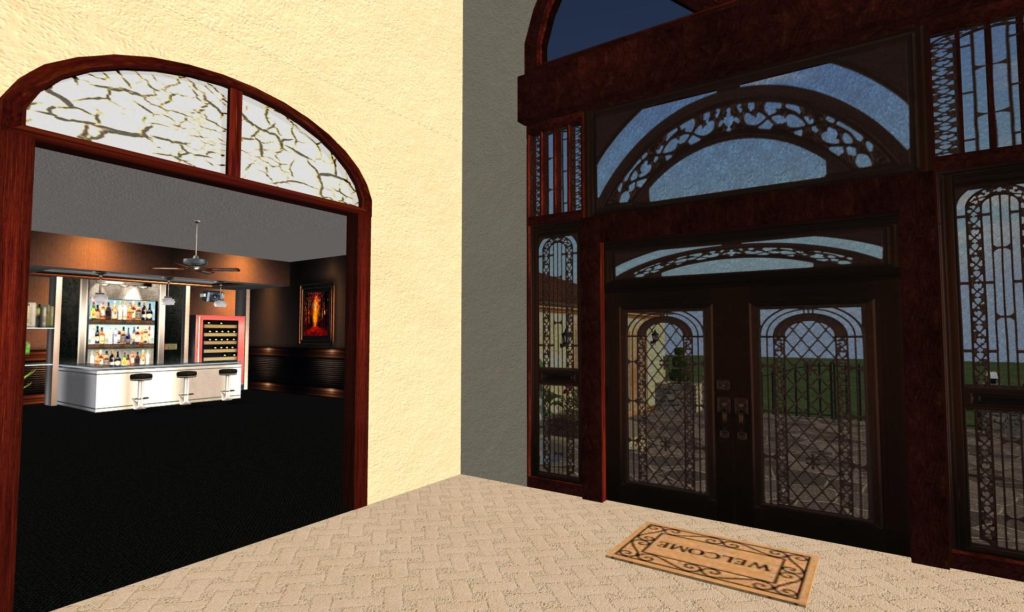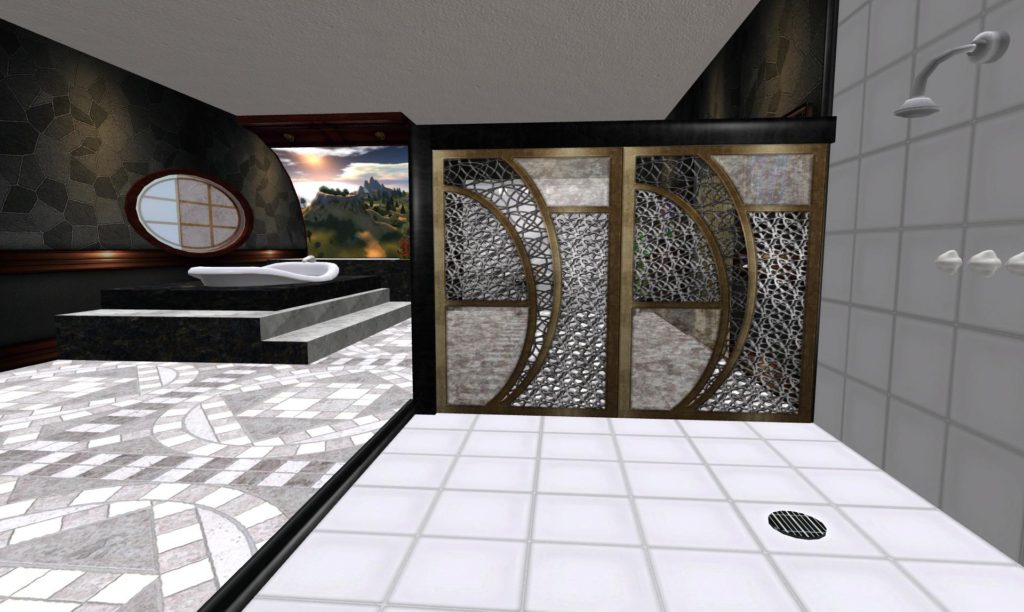All Silicon Estates homes are on a customized Homestead FULL SIM property. Your home will contain ALL the working scripts you’ll ever need, plus the finest furnishings available.
Each room is a breathtaking view. Every corner turned is a new wonder. The architecture of the building fits the environment and I personally guarantee that every island I custom create to your liking and usage will be worthy of a magazine spread, both for the architecture and the landscape.
I guarantee my work. If you don’t love it, don’t buy it. If you grow to hate it, I’ll change it. There is nothing I can’t do in Second Life, you have but to name it.
Guy goes into a roadside diner. “Whaddaya got ta eat?” he asks the counterman.
“You name it, we got it,” is the response.
“Okay, how about some steak and eggs?”
“Outta steak.”
“Well, make it ham, then.”
“Got no ham.”
“Bacon?”
“No bacon,” the counterman shook his head.
“I thought you said, ‘You name it, we got it’.”
“Yeah,” the counterman replied, “but you ain’t named it yet.”
Get the idea? You have to name the dish specifically, guess what he’s got in stock, decide that’s what you wanted anyway, and order it. No problem.
So what has that got to do with a wealthy rich moneyed architectural style estate on a private island somewhere in the Sea of Tranquility, which I own and operate as a self-appointed “High-End Real-Estate-Tycoon”.
Don’t quibble. It doesn’t become you. I’m a real estate maven, a market maven, whatever I declare myself to be.
I never said I was a GOOD real estate maven or an EFFECTIVE one. My documentation and reputation are staked on my results, so that’s what I’ll focus on in my marketing of High-End Real Estate in Second Life.
But wait a moment, what exactly am I marketing?
- ARCHITECTURE — Is is a specific type or style of architecture? No.
- LANDSCAPING — Could it be a specific kind of landscape, like an island? No.
Well, what IS it, then???
It’s more than style, more than content — it’s the ability to go with the flow, to sculpt the landscape and then the house, paint it and sign it, like any other artwork.
Within the house will be RARE or UNIQUE artworks, signed and dated and protected with permissions so YOU own it 100%.
You’re entitled to sell it, if you want to, but you can’t COPY it and you can’t MODIFY it, but you can TRANSFER it to another, to a buyer, and if you don’t sell it at a nice profit, it’s your own fault, because the ESTATE GAME — which is not new to Second Life — is played for the big splash.
You’re not charging a fortune to make the money. Give it away to a charity. That’s not the issue, not the issue at all.
It’s about class, style, elegance and architectural and landscaping wit. A touch of Class is what’s called for here, and you can supply your fancy architectural dreams to a variety of clients, all of whom fall under the category of “Highest Bidder”.
Oh, yes, your estates will GO TO AUCTION, where they will be bid upon by a variety of buyers, all of whom hope to make even more money off your estate than you did when they bought it from you.
The whole idea is to sell it for more than you paid for it, including monthly maintenance costs and cost of building and buying the land, all the hidden costs of owning properity in real life or virtual.
It comes to the same thing, and it’s gonna cost you plenty to hold onto property for very long, so I have a plan for that.
Don’t buy the land until you sell it.
That’s really easy, because it’s a private island, they come in only one size, although you can terraform it in a variety of ways — and you can name it pretty much anything you want, if you’re clever enough to avoid the obvious “takens” like “Paradise Island” and “Heavenly Gates”, although who knows??? Those names might be overlooked or abandoned and currently available, although a month ago, they weren’t.
How much money are we talking about?
Okay, you’ll be into the island for ZERO money, because your client is going to follow your instructions on how to buy which property that you select for them.
They will pay $350.00 setup charge and $229.00 per month maintenance fee, a transaction in which you have no part other than as a consultant.
You help your client set up an Avatar that is the Official Owner, and it’s with this Avatar that you will sculpt their lush and beautiful land, and build their elegant Architectural Digest style Estate Home, which can look like anything.
For instance, what if you wanted to have an island that … oh, wait a moment. Have we discussed the reason WHY someone would want such an island in a virtual world?
First of all, it’s probably the largest virtual community on the planet today, and you can resell property there pretty easily, at least at the moment, and improved property is at a premium, because most people are not builders or landscapers.
They hire them.
In your case, you’re going to BUY the house with the client’s own Avatar, so ownership will remain with your client, then you’ll INSTALL the house, furnish it where necessary, set up the scripts and permissions, door entry and all that sort of thing, make sure the dining goes okay and the fireplaces turn on, if there are any around.
Checking the pool to make sure it has the right depth and the floats are set with poseballs, and much, much more.
It all works, including the toilet, refrigerator and the coffee station on the breakfront. Look, this estate is TOTAL. It has every possible improvement and gimmick that’s available in Second Life, and YOU will put it all together.
Oh, you have no idea how?
Okay, so buy one of my estates — I’ve made dozens of them, and I’m making more right now, tonight, to fill orders in this Brave New World where Virtual Rules.
Yes, this is a totally safe way to cluster and gather and dance and play and cavort and otherwise romp and make whoopee.
In short, it’s a virus-free environment. That’s an attraction in itself. But why WOULD anyone want to buy a Virtual Island Estate, even if it is virus-free?
Before I can answer that, I have to tell you how much this will set someone back. I know I gave you the basic figures, but do the math, and you’ll see you need a new and inventive business model, or you’re going to fail.
But you WON’T fail if you follow this simple rule: “Don’t hold inventory.”
What that means is, build it somewhere — it doesn’t matter where — and take screenshots, plenty of screenshots at various times of the day. You don’t have to control the SIM in order to set the sun to different times, did you know that?
Go to “World” and travel your cursor down the dropdown menu to “SUN”, then select the sunrise, sunset, midday, midnight or regional setting, which might be different from all the others, and take a snapper in that lighting, then use the best ones in your ads.
But all the land in Second Life is marked “Zero” Linden. How can you sell in a market like that?
You can’t, and they’re NOT zero, they insist that you teleport into their office where they hit you with an onslaught of offerings, but you don’t have to fall for that sucker game.
HOW you buy property in Second Life is you learn how before you do it, because there are a zillion pitfalls, and you don’t want to get stuck with anything.
In order to start your business, you can do one of two things:
- BUY A FULL SIM — This gives you a whalloping 512 metres by 512 metres, on which you can build just about anything from an International Airport to a Royal Palace. Owning the SIM allows you to build anything you want to try building, with a full 20,000 prims with which to work, plenty for anything you have in mind. You’ll then sell the whole shebang and move to another island, or you can use this island for building and buy an island for them, meaning with their money and their Avatar.
- FIND SOMEWHERE TO BUILD — Getting building permissions is hard, and you’re taking prims away from someone else. It’s not the best solution, but you CAN fake it by renting a quarter-SIM for a week while you build, take snapshots and then take it all down again at the end of the week’s rental, sigh. Not a good way to go, but that’s how I started in Second Life, a little at a time, building it up slowly — but you can’t do that if you intend to sell an entire island landscaped down to the finest detail.
It’s all a question of money. Holding and using the FULL SIM property will cost you, as I said before, $350.00 U.S. for the setup charge, non-refundable, and you’ll pay an additional $229.00 for EACH SIM that you hold, plus “Tier Fees” for holding large amounts of property, like a land tax, imposed by Linden Labs, the owner of Second Life.
When you actually own it, you lose $229.00 every month you hold it. That amounts to a staggering $2,748 per year — almost as much as renting a small cabin on an obscure lakefront, it adds up fast.
That’s why lots of builders buy an island, split it up into smaller parcels, and then RENT the furnished parcels by the month or by the year.
Problem with that scenario is collecting the rent, as any real estate broker can tell you, and it’s heartbreaking to have to kick someone out for non-payment of rent, especially after a few months of no-rent, because as the owner, you have to keep paying every month, and it’s no easier for you than for them.
Renting to the poor is no solution to owning a piece of valuable real estate in a virtual world like Second Life.
You want to build and landscape with elegance and style, and that means taking up a lot of room and doing whatever you want to with it, and that takes money.
What you want to find is a large LIST of clients who want a virtual getaway and who can pay for it, have no trouble with money, and are making tons of it right now in the market and other avenues of income.
For some folks, money is never an issue, and yet they spend the most time and energy worrying about it.
Pardon me while I laugh.
So what kind of person has that kind of money and is attracted to the virtual virus-free world of Second Life?
First of all, I can easily name 1,000 things to do in Second Life, most of which are safe. Secondly, Second Life real estate has a good track record, at least so far, over a period of more than 15 years since its inception, and it still has good traffic and is the only game in town, and there have been plenty of attempts to replace it, all of which have failed.
Second Life is a proven marketplace winner. You can earn actual money in Second Life, by fishing, growing food for animals, breeding pets and gacha creatures, and of course piracy, meaning buccaneers — the role-playing pirates were the first major group to occupy Second Life, but they’re now outnumbered by the Buddhists, who have traffic in the thousands.
One of the usages for a customized island is a convention, lecture hall and meeting rooms, all of which can be tied to ZOOM meetings and other pathways to sharing.
It’s a great place to meet friends, and an art collection can be started, showing one acquisition at a time at an appropriate “Acquisition Party”, or an entire collection can be shown off all at once in an “Artist’s Reception” gathering, which can be strictly black-tie, and it won’t cost anyone more than a couple of bucks to dress for the occasion.
This is Second Life. Fashion is cheap and plentiful.
However, I have a plan for very expensive very exclusive artworks to go into the estate homes that you build for your clients.
This game is played somewhat like “Monopoly” in the sense that it is an acquisition game with relative values placed on various objects of art.
You can build an art gallery to show the works you’d like your client to buy.
You will then install those items for them in their estate home, and this can be done through your own Avatar, with group permissions granted — I’ll demo how this is done in my Estate Builder’s Course in ZOOM, which will be shown in the next workshop on Memorial Day Weekend, which is a three-day weekend event, and should be a blast, with a large world-wide attendance and participation.
Warning: attendance is limited by technology, so reserve a space now. I don’t know the details, but it’s easy to check with anyone here about it.
No one happens to be around right now so you’re on your own there — someone will know when, where and other details.
Meanwhile, let’s continue about this rich person’s virtual estate home in Second Life. How does it work?
You design everything on your own island, like I said. You then either sell that island or another island with that same thing on it to your client — it’s that simple.
But how much can you make?
If you maintain your own building island, you’ll have that expense, just like keeping a brick-and-mortar shop open for the walk-in trade.
If you sell strictly by the marketplace, you won’t have to own any more land than you need for your building, and that you can easily and cheaply rent.
When you’re designing and photographing an estate for sale, you want to have landscaping permissions, and that might be tough to find, but it can be done. There are rentals that will allow you to landscape your small property right up to the line.
You want waterfront, and full access to the land, not a surrounded piece that you get shot down trying to get to every time you go in there, and that’s gonna cost ya.
Not a lot, but some. Every advantage costs money, real money. Every gimmick earns you money, real money, but you have to know what the gimmicks are, and you need to avoid the ones that take advantage.
We don’t make money like that. In the Estate Game, we play by the rules! Ethics first. Style second. The “Bottom Line” — how much did you make off the deal? — is way down the list, but it IS important because it’s how you’re scored in the game.
Like I said, it’s not about the money, but winning is measured in money — success in building and landscaping is fine, you get the prizes, and the publication, but success in SELLING the property is by far the most important element in the Estate Game.
Gosh, I suddenly realized that we haven’t had that discussion yet — why on Earth would anyone want to knowingly and deliberately spend $229.00 a MONTH just to have a virtual estate to which one could retreat at any time of day or night?
I know a lot of people who would gladly pay that if they had it, but most people just don’t have a spare couple of hundred bucks every month, and they will probably never own a mansion, estate, palace or island of splendour, and they’ll never miss it, although they’ll dream of some special place of their own, some wondrous land of fantasy and glamour.
Problem is, those things cost money even in the virtual world, and someone’s gotta pay — in the case of that island, it’s gonna be you who pays the bill every month until you can figure out a way to sell two islands a month, which is what you’ll need to maintain your business plan.
Look, your client is gonna pay $3,000 bucks a month to maintain this virtual world, and it costs an additional $350.00 connection fee to Linden Labs, just to turn the thing on in the cloud.
Then every month, you pay, and pay and pay, and it never ends. There is no final sale price on land in Second Life. You’ll always pay a maintenance fee, every month — it’s not really a sale, it’s an OverRenter who can rent to lesser renters, but everyone pays every month to Linden Labs no matter what else happens.
Can you make anything doing this?
Hey, Andy Warhol was my Dad’s sci-fi illustrator back in the 1950s, but by the 1960s, he was a best-selling billionaire artist, and why?
Marketing.
As anyone with artistic taste and talent will tell you, Warhol’s stuff was garbage — strictly commercial art, not a speck of fine art in there.
Most of the Pop and Op artists of the time were billboard painters — I can name a dozen who were illustrators before fine art became a commercial success.
That was a product of the weirdness that evolved into the Japanese and German art markets, where you flew to America with your homeland currency, traded it in at double the value, bought art in America and flew back to your home country to sell the art there at double the price you paid in America — a double doubling of your money.
Once that economic advantage disappeared, the art market soon followed down the drain. Today, only the celebrity artist remains on the battlefield.
Fine art has no place in a world where your art collection is a cellphone app.
On the other hand, Fine Art does have a place in a virtual world, and a limited edition or a unique one-of-a-kind piece is worth more than one that isn’t is worth some real money, payable in paypal which translates to any national currency you happen to carry.
So with Marketing, the art you sell could be worth hundreds or even thousands of real dollars.
The catch is, you have to make it worth real dollars, but how???
Scarcity is the number one reason you can ask serious money for it, but there are three vital conditions that create price in the art and collectibles market:
- SCARCITY — How RARE something is makes a difference. In general, a one-of-a-kind is worth more than a copy of something that had an edition of more than one.
- DESIRABILITY — If nobody wants it, it doesn’t matter how cheap it is. If everyone wants it, the price can soar, particularly at a live auction, which is how your estates are going to sell the best.
- CONDITION — In the real world, condition is everything. As a matter of fact, the same holds true in the virtual world. In the virtual, “condition” means security issues have been handled.
Original artwork in a UNIQUE architectural setting is what you’re selling, plus exposure, publication — you want to start an online social media outlet showing all the different estates that are competing to achieve recognition in the world of Virtual Estates.
“What happens in the Virtual World is not important.”
That’s the implied fundamental fact, but it just isn’t true. Experiences have a lasting effect, and virtual experiences are no different.
In fact, the virtual world has plenty of impact on the real world, even if you yourself never play a video game or enter into a virtual world.
Did you know that you can design virtual fashions and not have to manufacture them until they’ve sold?
Well, the same is true about a house. You can design a house in Second Life, then have an architect craft up the plans and do the snow-load and other engineering details, and you can achieve a reputation as a HOUSE DESIGNER.
Not an architect — for that, you need the degree in engineering, but as a designer, and that can mean big bucks for you and your family, or for your favorite charity.
It’s all up to you to build a market for your estates and your choice of artwork with which to populate it.
It’s entirely up to you to design a layout and create a lush and overwhelming atmosphere of elegance and style.
Having a social dynamic adds a ton of “punch” to your offerings, so it would be well to establish a country club with estate owners able to join — of course, it’s juried by a bunch of intentional snobs.
I told you this game is played like “Monopoly”. Do you have any idea what that game is about?
There are four kids sitting around the board, each one with the intention of driving the other three to economic ruin.
“Last Stockholder Standing” is the name of the game.
Of course you yourself don’t want to have any part of this game — you’re on a spiritual quest and can’t be bothered with life-distractions, particularly rich peoples’ games like owning land, fabulous palaces and mansions and world-famous works of art.
Clocks are good. How about a closet-full of incredible RARE clothing? Did I mention clocks???
You’ll figure out what each client will love in their virtual home and you’ll work hard to make that happen, but it will cost them plenty, and if they’re counting the bucks, it won’t work out well for either of you.
There’s another reason someone might want to buy one of these islands of yours … money. What if they can sell it at a profit? Suppose it becomes even more desirable over the years?
Problem is, you can’t possibly ever get the money back you put into owning it over time — you’re still paying for the land every month, even though you “bought” it.
There’s only one way out of that bind — don’t buy it until you sell it.
But how will THAT work out???
You’ll have to build it to sell it, but how??? The simple answer is, rent the land while you build and organize and design.
You’ll still pay a monthly fee, but no front money and you can quit anytime, when you’re not building.
The other way to go is to own a full SIM and rent shops in there, offsetting the monthly cost of owning it and use a portion of the island to make your estate homes and set up your landscaping projects.
You’ll have to fake some of the screenshots to make the place look like it’s full-SIM, but you can do it, and I can show you how, so you don’t bear the burden of that $229.00 a month — you can at least reduce that amount somewhat, depending on how many friends you have in Second Life to put up those shops.
You’ll have to limit the prims seriously in order to achieve both goals — building and renting.
If you can afford to buy an island just for building and designing and landscaping, it’ll be a lot easier on you, and you can leave projects up for a while without disturbing the neighbors.
Improvement of the property can result in a small amount of pocket change or a large supportive amount on which you and your family can live.
What’s the difference? Marketing.
So how much is this estate you’re seeing here gonna set someone back? I’ll sell the island for L$1,100,000.00 — that comes to exactly U.S. $3,125.00 and cheap at half the price!
That’s a simple transfer, and since you used their Avatar to buy the stuff and make the island paradise, they already own everything there.
This includes over a dozen signed protected one-of-a-kind original works of art. It’s not happening yet, but virtual art will eventually sell for the same money as “real” art. It’s a guarantee that this will happen, and maybe it’s you that makes it happpen!
How much will it actually auction off for? Well, the whole idea is that it IS expensive, and so you’ll need a sort of Beverly Hills setting for it to make it more valuable real estate, and that’s what I propose we start up right now, without delay!
PROSPERITY PATH COUNTRY CLUB & ESTATES
How it works is, your SIM is associated with the Prosperity Path Country Club, which has its own 18 hole golf course and many other SPA and RELAXATION features.
Where is this country club?
At the moment, it’s in our Ashram, but with a lot of traffic, we’ll have to move it somewhere more commercial and exposed, maybe on the Mainland.
The country club can have a number of social events and planned webinars and more. You can make it attractive by populating the country club and making it a Destination Place.
So get with the program. Learn effective and FREE marketing in our GORBYZOOM Webinars!
Learn how to build in Second Life! Learn how to create great virtual items! Play virtual games. Meet with virtual friends! Do virtual things for a living!
Imagine what the price would be on this luxury island estate if it had been designed by Andy Warhol or David Hockney, both of which produced art that sucks but sells well.
It doesn’t have to be great to be expensive, but it DOES have to be desirable, and that’s the real catch. Find something that EVERYONE wants a piece of, and that’ll be a sumptuous estate with a staff of ready servants and a host of luxurious accents.
There are several saunas and hot tubs in this setup, and your customer will pay dearly for each profound addition to the scene. Of course, they’re fully custom scripted just for you.
Sell a million Linden Dollar home today, and retire for up to a couple of days. What I mean is, so you sold one — now do it again!
See You At The Top!!!
gorby


